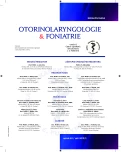Deaf-Blindness from the Health and Social and the Legislative Perspectives
Authors:
A. Pellant 1; R. Michálek 1; Jan Mejzlík 1; E. Mejzlíková 2
Authors‘ workplace:
Klinika otorinolaryngologie a chirurgie hlavy a krku Pardubické krajské nemocnice, a. s. a Fakulty zdravotnických studií Univerzity Pardubice
1; Oční oddělení Pardubické krajské nemocnice, a. s.
2
Published in:
Otorinolaryngol Foniatr, 62, 2013, No. 3, pp. 111-116.
Category:
Original Article
Overview
Serious hearing impairment or even bilateral hearing loss, combined with bilateral severe vision impairment or complete vision loss, rank among the most severe handicaps of human senses. Unfortunately, a high percentage of impaired individuals contemporarily suffer from other bodily and intellectual handicaps, both congenital or acquired in the course of life and frequently growing with age, making the definition and legal classification of this impairment considerably more difficult. From the medical point of view, and especially from assessment medicine’s perspective, deaf-blindness should be a precisely defined terminological definition and diagnosis established by an objective contemporary vision and hearing impairment, with consideration to other identified health handicaps. From the health-social perspective, when assessing the overall condition of death-blind patients, their quality of life, communication skills and degree of reduction of their constant gainful occupation ability must be taken into consideration as well as a determination of the extent of necessary support of the impaired. Unfortunately, despite the arguments stated above, the efforts to define unifying criteria of deaf-blindness, which would satisfy the expectations of both parties, have failed so far. However, the involved parties agree that despite the very serious situation, it is nowadays possible to apply a suitable and complex approach to achieve a partial relief of the patients’ severe handicaps.
The authors provide a broad view to the above-stated problem area from health-social and legislative perspective. From the ORL perspective, they see a positive contribution in an early introduction of compulsory overall hearing screening of newborns using otoacoustic emissions and, in indicated cases, in cochlear implantation with subsequent rehabilitation and long-term logopedic therapy.
Keywords:
deaf-blindness, health and social domain, legislation
Sources
1. Aksenovová, Z., Kabelka, Z.: Výsledky kochleárních implantací u hluchoslepých dětí. Otorinolaryng. a Foniat. /Prague/, 59, 2010, č. 2, s. 51-54.
2. American association of the deaf blind. Support service providers for people who are deaf-blind [online]. 2006 [cit. 2012-12-08].
Dostupné z: http://www.aadb.org/information/ssp/white_paper_ssp.html
3. Brožík, J.: Kolik je u nás hluchoslepých. GONG: Časopis sluchově postižených [online]. 2012 [cit. 2013-01-06]. Dostupné z: http://www.gong.cz/clanky.php?c=100.
4. Canadian deafblind and rubella association-BC: Causes of Deafblindess [online]. Last updated 24th November 2006 20 : 27 : 56 [cit. 2013-01-08]. Dostupné z: http://www.cdbrabc.ca/causes_of_db1.html.
5. Česká republika: Metodický pokyn k provádění screeningu sluchu u novorozenců. In: Věstník Ministerstva zdravotnictví České republiky. 2012, 7. Dostupné z: http://www.mzcr.cz/dokumenty/metodicky-pokyn-k-provadeni-screeningu-sluchu-u-novorozencu_6712_1.html.
6. Dammeyer, J.: Prevalence and aetiology of congenitally deafblind people in Denmark. Int J. Audiol., 49, 2010, s. 76-82.
7. Gallagher, J.: A-Z to deafblindness: Welcome to A-Z to deafblindness [online]. Last updated on the 17th september 2002 [cit. 2013-01-08].
Dostupné z: http://www.deafblind.com/index.html.
8. Hanus, J.: Klub přátel červenobílé hole: Hluchoslepota [online]. Změněno 11. prosince 2011 2 : 37 : 18 [cit. 2013-01-08]. Dostupné z: http://www.klubpratel.wz.cz/hluchoslepota.html.
9. CHARGE syndrome foundation: About CHARGE. In: [online]. [cit. 2011-09-17]. Dostupné z: http://www.chargesyndrome.org/about-charge.asp.
10. Kowalik, S., Bańka, A.: Perspektivy rehabilitace hluchoslepých. Wagner Press Praha, 2000, 133 s.
11. Langrová, I.: Vymezení pojmu hluchoslepota. Tyflologické listy [online]. 1998, 1-2. Dostupné z: http://www.braillnet.cz/sons/docs/tl98/studie4.htm.
12. Langrová, I., Galvas, Z.: Hluchoslepota a formy pomoci dospělým osobám s kombinovanou zrakovou a sluchovou vadou. OASA (Informační a metodický bulletin) č. 5/1997.
13. LORM – Společnost pro hluchoslepé. Definice hluchoslepoty: Poslední trendy v pojetí definice hluchoslepoty v zahraničí a České republice [online]. 2009-03-09 [cit. 2013-01-08]. Dostupné z: http://lorm.cz/cs/hluchoslepi/definice-hluchoslepoty.php.
14. LORM – Společnost pro hluchoslepé. Česká verze Lormovy abecedy [online]. 2007-05-31 [cit. 2013-01-08]. Dostupné z: http://lorm.cz/cs/hluchoslepi/abeceda.php
15. Ludíková, L.: Vzdělávání hluchoslepých I. Scientia Praha, 2000, 74 s.
16. Ludíková, L.: Vzdělávání hluchoslepých III. Scientia Praha, 2001, 78 s.
17. Ludíková, L.: Kombinované vady. Olomouc Univerzita Palackého, 2005. 140 s.
18. Ludíková, L., Souralová, E.: Základy znakové řeči pro hluchoslepé. Olomouc,Univerzita Palackého, 1994. 42 s.
19. National consortium on deaf-blindness. Causes of deaf-blindness [online]. [cit. 2013-01-08]. Dostupné z: http: /www.nationaldb.org/ISSelectedTopics.php?topicCatID=24
20. Pellant, A., Šram, F., Valvoda, J., Kabelka, Z.: Současná problematika hluchoslepoty z pohledu otorinolaryngologa. Otorinolaryng. a Foniat. /Prague/, 50, 2001, č. 2, s. 103-105.
21. Sbírka zákonů, Česká republika. Zákon č. 384/2008Sb, částka 124 ze dne 23. září 2008, kterým se mění zákon č. 155/1998 Sb., o znakové řeči a o změně dalších zákonů a další související zákony. Dostupné z: www.mvcr.cz/soubor/sb124-08-pdf.aspx.
22. Sbírka zákonů, Česká republika. Vyhláška č. 290/2011 Sb. Částka 102, ze dne 22. září 2011, kterou se mění vyhláška Ministerstva dopravy a spojů ČR č. 30/2001 Sb., kterou se provádějí pravidla provozu na pozemních komunikacích a úprava a řízení provozu na pozemních komunikacích ve znění pozdějších předpisů. Dostupné z: aplikace.mvcr.cz/sbirka-zakonu/ViewFile.aspx?type=c&id=6020
23. Sbírka zákonů, Česká republika. Zákon č. 329/2011 Sb. ze dne 13. října 2011 o poskytování dávek osobám se zdravotním postižením a o změně souvisejících zákonů. Dostupné z: aplikace.mvcr.cz/sbirka-zakonu/ViewFile.aspx?type=c&id=6064
24. Souralová, E.: Vzdělávání hluchoslepých II. Scientia Praha, 2000, 78 s.
25. Souralová, E., Horáková, R.: Problematika osob s hluchoslepotou a kontaktní tlumočení u hluchoslepých preferujících český znakový jazyk. Česká komora tlumočníků znakového jazyka, o.s., Praha, 2008, 78 s.
26. The national coalition on deafblindness [online]. 2012 [cit. 2012-12-08]. Dostupné z: http://www.dbcoalition.org/about.htm.
27. Tyfloservis [online]. 2012 [cit. 2012-12-08].
Dostupné z: http://www.tyfloservis.cz/vz2001/11.php.
28. Velká Británie. Social care for deafblind children and adults. In: Department of Health, 2009. Dostupné z: http://www.dh.gov.uk/en/Publicationsandstatistics/Lettersandcirculars/LocalAuthorityCirculars/DH_101114.
29. Vymlátilová, E., Příhodová, J., Šupáček, I., Doubnerová, M., Kabelka, Z.: Faktory ovlivňující využití kochleárního implantátu u dětí. Otorinolaryng. a Foniat./Prague/, 48, 1999, č. 3, s. 131-134.
Labels
Audiology Paediatric ENT ENT (Otorhinolaryngology)Article was published in
Otorhinolaryngology and Phoniatrics

2013 Issue 3
Most read in this issue
- Vestibular Migraine in the Otorhinolaryngologist's Out-patient
- Nocardia abscessus – Unusual Source of Nasal Inflammation
- Late Post-Intubation Pneumomediastinum and Cervical Emphysema
- Chondrosarcoma of Cricoid Cartilage
